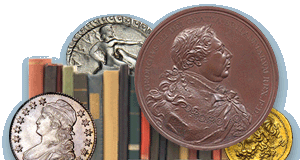|
PREV ARTICLE
NEXT ARTICLE
FULL ISSUE
PREV FULL ISSUE
The E-Sylum: Volume 3, Number 30, July 23, 2000, Article 9NUMISMATIC TERMS STANDARDIZATION COMMITTEECOIN WORLD Editor Beth Deisher writes; "The introduction to the "Numismatic Terms and Abbreviations" chapter in the 1976 Coin World Almanac (first edition copyright 1975) notes: "To standardize the definitions of the most important, and most controversial, numismatic terms, the American Numismatic Association in 1966 appointed a 21-member blue-ribbon panel of experts to serve on the Numismatic Terms Standardization Committee. The committee was reappointed in late 1967 with several personnel changes and is still in existence. A second revised edition of the terms is due shortly. "Those definitions which follow here are given exactly as described in ' The Dictionary of Numismatic Terms' published by the ANA terms committee, and published here by special permission from the ANA. Several definitions have been expanded for reader benefit into the working definitions used by Coin World, World Coins and Numismatic Scrapbook." Editors responsible for each successive edition of the Coin World Almanac have reviewed the terms and added or refined as necessary to reflect the working definitions used by Coin World. I have been working at Coin World 19 years and covering the ANA Board of Governors for the last 16 years. I do not recall that a "terms committee" has met or been active in the last 19 years. It's an interesting area and I'll check with Ed Rochette at ANA. Perhaps it's time for another committee of experts to review and/or discuss adding new definitions." COIN WORLD News Editor William T. Gibbs adds: "The Almanac chapter has been updated with each new edition, including the seventh edition, which is now at the printer. It should soon be available. The latest edition will include several terms that did not exist when the original edition was published in 1975. Many Coin World staff members have contributed to the "Numismatic Terms" chapter since the first edition was published. The new Almanac also will contain an updated chapter on numismatic literature, including the addition of a number of works published since the sixth edition was published in 1990." Finally, Beth Deisher reports that the new Almanac edition "is at the printers and we hope to have copies at the ANA in Philadelphia." [Editor's note: a trip to my library unearthed a pamphlet titled "The Dictionary of Numismatic Terms", published by the ANA. It is marked as the "Third Edition - 1975" No mention of the committee is given, but foreword by John Jay Pittman notes: "The association welcomes and solicits suggestions, additions, and criticisms to this edition of the American Numismatic Association's "The Numismatic Terms Dictionary." There is a definite and pressing need for a term which will adequately describe a "coin dealer." We would appreciate your ideas." I'm sure some rather colorful terms for "coin dealer" were submitted, which brings me to a final, non-numismatic question: What ever became of Walter Breen's manuscript for "The Cynic's Dictionary?" Something he'd been compiling for years, the Cynic's Dictionary was comprised of satirical definitions for various words.] Wayne Homren, EditorContent presented in The E-Sylum is not necessarily researched or independently fact-checked, and views expressed do not necessarily represent those of the Numismatic Bibliomania Society. This is a static archive page documenting the originally published content. Links were active at the time of publication but may no longer work. Check subsequent issues for corrections and commentary. The Numismatic Bibliomania Society is a non-profit organization promoting numismatic literature. For more information please see our web site at http://www.coinbooks.org/ There is a membership application available on the web site. To join, print the application and return it with your check to the address printed on the application. Visit the Membership page. Those wishing to become new E-Sylum subscribers (or wishing to Unsubscribe) can go to the following web page link. To submit items for publication in The E-Sylum, write to the Editor at this address: E-Sylum Editor Copyright © 1998 - 2024 The Numismatic Bibliomania Society (NBS) |

